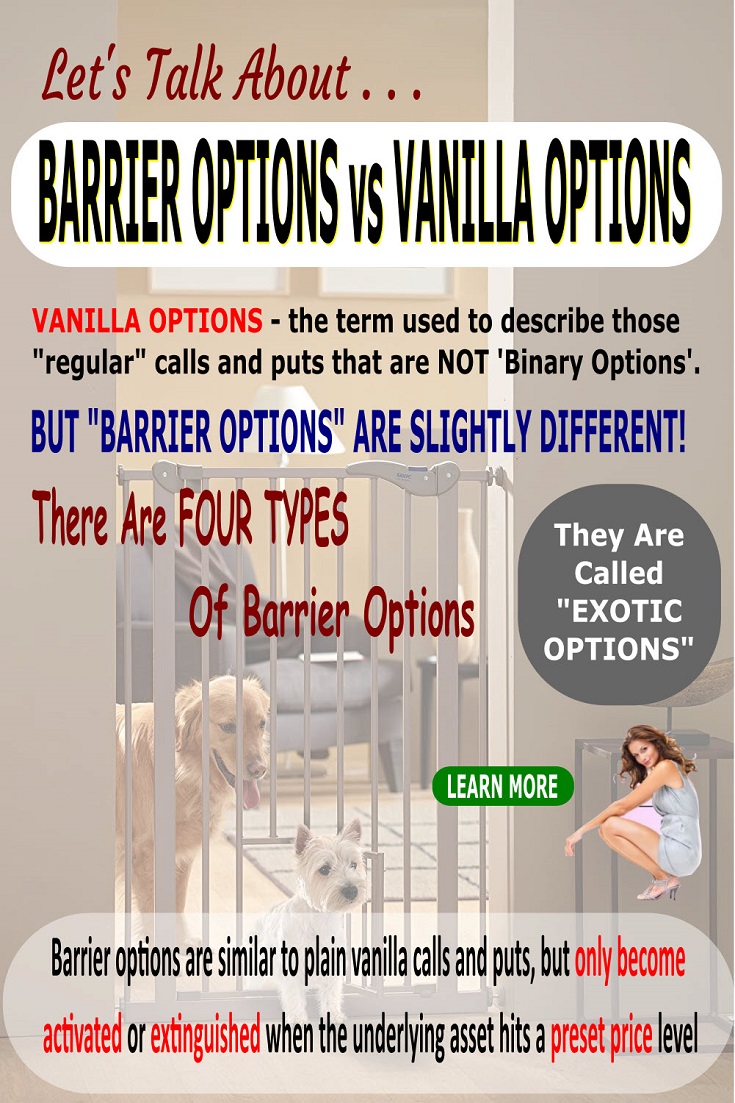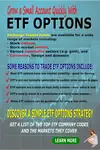Search Options Trading Mastery:
- Home
- Explain Option Trading
- Barrier Options
Barrier Options vs Vanilla Options
Defining Barrier Options and How to Use Them
Barrier options are distinguished from regular, or vanilla options by the addition of a particular price point, or barrier. When the price of the underlying asset reaches this point, the option either comes into existence or ceases.
As such, they are among the more exotic options types because they don't follow the usual rules.
If the option comes into existence at a price barrier, it is sometimes called an "up and in," "knock-in," or "down and in" option.
If the option is automatically cancelled at a price barrier, it is sometimes called an "up and out," "knock-out," or "down and out" option.
You get the idea?
To take an example, if you've purchased "knock-out" type barrier call options on XYZ company and the price of XYZ reaches the nominated price barrier, the options is automatically knocked out and becomes worthless. In some cases you may receive a fraction of the cost back as a cash rebate.
Because of these extra conditions, barrier options are usually cheaper than traditional vanilla options. So they can serve the purpose of providing either leverage or hedging benefits at a cheaper price, as long as the underlying remains within certain price limits.
For the discount price you're willing to either take the extra risk that the barrier won't be reached, or from a hedging perspective, only need the option once the underlying crosses the price barrier.
The four main types of barrier options are:
- Up-and-out: spot price starts below the barrier level and has to move up for the option to be knocked out.
- Down-and-out: spot price starts above the barrier level and has to move down for the option to become null and void.
- Up-and-in: spot price starts below the barrier level and has to move up for the option to become activated, or "knock in".
- Down-and-in: spot price starts above the barrier level and has to move down for the option to become activated.
Barrier Options Pricing
When determining the fair value of this type of option, an additional factor has to be taken into account - where the underlying asset is in relation to the nominated price barrier.
Because of this, they are called "path-dependent".
Traditional options are valued solely on where the price of the underlying is in relation to the strike price and time to expiration, together with any implied volatility as a result of supply and demand factors.
But barrier option pricing includes this additional feature - the price barrier.
Example - The "Knock In"
Consider a knock-in call option with a strike price of $50 and a knock-in barrier at $55.
Suppose the option was purchased when the underlying asset was trading at $45. If the option expired with the underlying at $52, but it never reached the barrier level of $55 during the life of the option, the option would expire worthless.
On the other hand, if the underlying first rose to the $55 barrier, this would cause the option to knock-in. It would then be worth $2 when it expired with the underlying at $52.
This video may help explain this type of option in simple terms:
Double Barrier Options
This is a combination of two dependent knock-in or knock-out options. If one of the barriers are reached in a double knock-out option, the option ceases to exist. If one of the barriers are reached in a double knock-in option, the option comes into existence.
These triggers define the allowable range for the price fluctuation of the underlying asset. In order for the investor to receive a payout, one of two situations must occur; the price must reach the range limits (for a knock-in) or the price must avoid touching either limit (for a knock-out).
*************** ***************
Return to the Explain Option Trading contents page
Or Go to the Options Trading homepage















New! Comments
Have your say about what you just read! Leave me a comment in the box below.